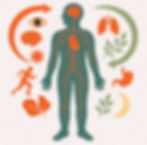Introduction to the Nervous System: Understanding Regulation and Balance
- Dana Yoga
- Sep 9
- 2 min read
We hear about the nervous system all the time — in yoga, in therapy, in wellness — but what exactly is it, and why does it matter?
The nervous system is your body’s communication network. It connects the brain, spinal cord, and nerves, sending signals to every part of you — from your heartbeat and breath to your emotions and reactions. It’s the system that lets you sense, respond, and connect with the world around you.
The Two Main Branches of the Nervous System

The nervous system has many layers, but two branches affect our daily lives the most: the sympathetic nervous system and the parasympathetic nervous system.
1. The Sympathetic Nervous System
Often called the “accelerator.”
Activates the body when you need energy, focus, or protection.
Raises heart rate, speeds breath, sharpens senses.
Prepares you to respond quickly to stress or challenge.
Known as the fight or flight response.
2. The Parasympathetic Nervous System
Often called the “brake.”
Calms the body and slows the breath.
Supports rest and digest functions like sleep, digestion, and healing.
Helps you feel safe, grounded, and connected.
Healthy regulation means both systems can move in balance: speeding up when you need, and slowing down when it’s safe again.
What Happens When the Nervous System is Dysregulated?
When the nervous system moves out of balance, it doesn’t stay calm — it shifts into survival.
This is when we experience the stress responses known as fight, flight, freeze, and fawn.

Fight: anger, defensiveness, irritation.
Flight: anxiety, avoidance, restlessness.
Freeze: numbness, feeling stuck, disconnecting.
Fawn: people-pleasing, keeping peace at your own expense.
These responses are not flaws — they are the body’s way of keeping you safe. The challenge comes when they get stuck, repeating even when there is no real danger.
Why Nervous System Regulation Matters in Daily Life
The state of your nervous system shapes:
Your patience in relationships
Your ability to think clearly under stress
The quality of your sleep and digestion
How safe and connected you feel in your body
Learning to notice your nervous system states is the first step toward regulation. Awareness creates space to pause, breathe, and choose a different response.
Tools for Nervous System Regulation
Awareness is the starting point. From there, gentle practices can help bring balance:
Breathwork: slowing and lengthening the breath calms the system.
Movement: yoga, walking, stretching, or even shaking off stress.
Rest: prioritizing sleep and giving your body safety cues.
Connection: co-regulating with safe people through presence, touch, or conversation.
These simple practices remind your body that it is safe to return to calm.
Your nervous system is not your enemy — it is your oldest protector. The more you understand it, the more compassion you can bring to yourself.
With compassion and awareness, survival can shift into freedom.